|
Lignumvitae Key |

|
We went to see the lignum vitae trees and we did.
Just don’t ask us what one looks like. (Well,
okay, we did look them up on a website when we got
back.)
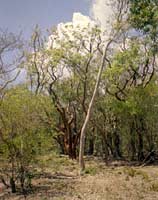 |
The dark
trees in the background look like the
picture we found after the trip on the
Internet.
(click
images to enlarge) |
|
The occasion was a recent trip to South Florida
and the Florida Keys that combined visiting relatives,
business, and vacation. Around midweek, we found ourselves
with free time and decided to kayak to Lignumvitae
Key, about a mile into Florida Bay from the bridge
and spoil island that connects Upper and Lower Matecumbe
Keys, a few miles south of Key Largo.
| This clump
is another likely candidate. |
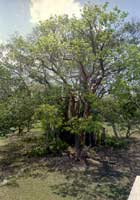
|
|
I had always wanted to see the famed lignum vitae
tree, renowned among old time shipbuilders. One of
the hardest and heaviest woods in the world, it can
be heavier than water and consequently sink. It is
highly rot resistant (one website recounts lignum
vitae posts in Indian dwellings on St. Thomas being
800 years old) and will rapidly dull tools used to
cut and work it. It only grows in the U.S., if I recall
correctly, on the Keys and most of it is gone there,
except on Lignumvitae Key, which is owned by the state.
Lignum vitae means long life in Latin, and its characteristics
have earned it the nickname “Tree of Life.”
We had been unable to bring our own, comfortable 15
½-foot, two-person kayak, so we rented a 10-11
foot two person sit-on-top model from Marathon Kayaks
(www.marathonkayak.com)
and headed up the Keys.
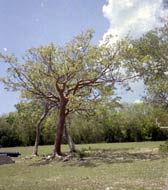 |
This has
possibilities, but were less sure it’s
the "Tree of Life."
|
|
It was time to take stock. I’m in pretty good
shape, but have less than optimal eyesight. Helen
has excellent peepers, but has been bothered by an
old injury in her right shoulder, a fresh case of
tennis elbow in her right arm and carpal tunnel in
her left wrist. We figured there was one healthy person
between us, and that should be enough.
I did forget that Helen, while intrepid, has a highly
developed sense of self-preservation. When encountering
new situations or the unknown, she will tend to assume
the worst until shown otherwise. Her predilection
would be given plenty of exercise this day.
We launched from the spoil island between Upper
and Lower Matecumbe Keys. This used to be a paved
ramp, with a seawall on either side, and no dock.
Recent hurricanes have left the seawall as rubble
and the ramp is sand. That actually made the kayak
launching easier, and judging from the other boat
trailers parked there, it wasn’t causing the
power boaters any difficulty either.
We shoved off and got the feel for the sit-on-top
kayak. It seemed to have plenty of stability, although
it felt a bit tippier than our kayak. Also, without
a foot-pedal-controlled rudder, we found it harder
to keep a straight course.
Nonetheless, we bravely zig-zagged from shore toward
Lignumvitae Key, all of about a mile away. Our course
would take us over a series of shallows interspersed
with channels of much deeper water. It was hitting
that deep water in a still unfamiliar craft that triggered
Helen’s first bout of self-preservation –
the state of her nervousness seemed directly related
to the distance to the bottom. I assured her we were
okay as the wind was gentle and the chop negligible.
This worked for a few minutes until, in about five
feet of water, we provoked a noticeable stir in front
of us. Two sharks, one about five feet and one about
six, went streaking along the bottom by the kayak,
one on each side, neatly bracketing us.
“Sharks,” said Helen.
“Don’t worry. They’re lemon sharks,”
I replied. That’s what we tell tourists in Florida
when they see a shark, that it’s generally a
mostly harmless lemon or nurse shark. Actually, I
had no idea, but later found out, from the brief glimpse
I had, that they were indeed probably lemon sharks.
At least they showed no noticeable interest in us
other than getting away from us as fast as possible.
Maybe they found my paddling technique objectionable.
A little bit further on, we reached a channel and
even deeper water, deep enough that we couldn’t
see the bottom despite the clear water. Although I
had told Helen her paddle was, in light of her injuries,
for decorative purposes only, she decided this would
be a good time to pitch in. There was a noticeable
increase in the leisurely pace I had been setting.
A few minutes later, we were in shallower water,
and shortly after that at the island. We could see
a big dock where the park rangers shuttled over most
visitors, and a smaller dock for their service boats.
Both were empty. Next to the smaller dock was a sign
in an opening in the mangroves proclaiming it as a
kayak landing.
| We decided
to kayak to Lignumvitae Key, about a mile
into Florida Bay from the bridge and spoil
island that connects Upper and Lower Matecumbe
Keys, a few miles south of Key Largo. |
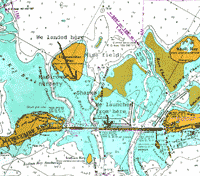
|
|
We beached and set out on our quest for the lignum
vitae trees.
Except there was no one there to tell us where they
were. (Helen notes: Now, despite reduced government
spending, it would seem appropriate to at least hoist
signs up, indicating the famous trees! Certainly other
adventurers have stopped at this key in search of
the unknown!)
There was a white building (apparently the home
of the island’s former private owner) in the
center of a mostly cleared area, set up on arched
pillars, and a smaller building behind it that looked
like a water catchment structure. There was no visible
way into the smaller structure, and the larger one
was locked. Off to the side of the cleared area were
restrooms and a bit further back was what looked to
be a 1930s vintage pickup truck that appeared to be
a pile of rust held together by memory.
We poked around the mostly cleared area, but there
were no signs identifying the trees. We were pretty
sure the spindly trees with the fronds at the top
(palms) weren’t lignum vitae. And I managed
to recognize one tree as a type of oak. But the rest
were mysteries. We shot pictures of several trees
and clumps of trees and figured somewhere in there
was a lignum vitae. We could actually claim to have
seen one, as long as no one pressed us for details.
(Helen, digging an elbow into my ribs as I write
this, notes that the reddish-bark tree she pointed
out on the island as the most likely lignum vitae
candidate is the one that matches the picture we found
on the website after returning home.)
The mosquitos were discovering our presence and
we decided to beat a retreat, after Helen visited
the restroom. Where, alas, she had her second acute
bout of self preservation.
Okay, so even though it was broad daylight, it was
a little eerie being on the key with no one else around,
not even friendly signs to guide us. That apparently
was the sense that overtook Helen when she went into
the restroom and looked under the toilet seat and
saw . . . not a comforting porcelain bowl but the
deep, black hole of a primitive privy. Deciding discretion
was the better part of valor, she exited, unrelieved.
(Although I kidded her about this, it was not necessarily
a bad decision. I have a vivid recollection of the
rangers at Canyonlands National Park warning my bother
and me to carefully check under the seats of their
primitive outhouses, lest a lunking black widow spider
bite us in places difficult or painful to apply a
tourniquet. We had no one to warn us of what lurked
in dark places on Lignumvitae Key . . .)
We shoved off and paddled to the big dock where
the tour boat lands. There was a big sign, announcing
tours every day at 10 a.m. and 2 p.m., except on Tuesdays
and Wednesdays, when there were no tours. Today, of
course, was Wednesday.
One mystery explained, we pondered our options. We
could head back, but I wanted to paddle some more.
Two miles eastward was Shell Key, but that felt a
bit far. So we decided on a daring circumnavigation
of Lignumvitae Key.
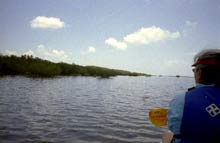 |
Helen
surveys the baby mangroves sprouting off
the southwest corner of the island.
|
|
Off we went. The water was deeper than I expected,
but only 3-4 feet and startlingly clear. (I had been
conditioned by Chuck Leinweber’s and my recent
passage across the shallows of Florida Bay, a few
miles to the north of where we were now, and had half
expected to be pushing the kayak more than paddling.)
Other than a few no trespassing signs among the
mangroves on the shore, there was nothing but island,
clear water, blue sky and sun. We hadn’t paddled
far when Helen asked me if I had noticed the round
objects here and there on the bottom, the ones with
the funny, sort-of-metallic-looking center. I confessed
I hadn’t seen them, being preoccupied mostly
with keeping the kayak straight.
“You don’t think they’re underwater
mines, do you,” Helen asked, in the throes of
her third bout of self preservation.
Mines! Okay, so there were no trespassing signs,
but enforced by mines?
| Helen digs
in as we cross over the minefield. |
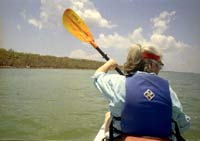
|
|
Presently we came upon another cluster of the circular
menaces and I could see that they were — sponges,
globular shaped with holes in the center. Later, an
inquiry to a marine biologist produced the information
they were most likely the common loggerhead or black
ball sponges.
Eventually it occurred to me that I had purchased
a perfectly good disposable underwater camera and
could stick it under the surface and take a picture
of the “mines.”. But by then, we had passed
the last of the sponges (which seemed to be on the
north side of the island), so the outer defenses of
Lignumvitae Key went unphotographed. (The mosquitos
are the inner defenses.)
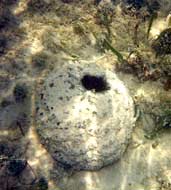 |
Shot on
an earlier trip to the Keys, this is an
underwater photo of what we how have dubbed
the "underwater mine" sponge.
They look a lot deadlier from above the
water . . .
|
|
The western end of the island somehow seemed a bit
wilder, perhaps because now the island blocked the
view of civilization. The southern side, still marked
with no trespassing signs, had small sandy beaches
here and there and a windblown look, probably from
the hurricanes that passed nearby last year. The southeastern
corner was enchanting as it appeared to be a mangrove
nursery. Sprigs from a leaf or two in size to small
clumps of branches dotted the water, giving the impression
the island was reaching out, seeking to grow in that
direction. Our starting point for the adventure came
into view.
We soon completed our rounding of the island and
headed back to our truck. Helen was more relaxed this
time over the deep water. She occasionally had been
paddling, but suddenly about halfway back, over the
deepest water, she began applying her double paddle
in earnest, and our speed leaped upward. Rumors that
cigarette boats came over to check out the resulting
rooster-tail wake, however, are exaggerated.
Helen waited a minute to tell me the reason for
the burst. “Sharks on the bottom,” she
said. “Two of them.”
She didn’t get a good look (okay, to be accurate,
neither she nor the sharks hung around long enough
for a careful examination), but Helen was sure of
two things: 1) They were a lot bigger than the first
two we had seen; and 2) they were a lot meaner. I
was disappointed at missing them, but we obviously
weren’t going back.
The spurt put us close to shore and we landed back
on the ramp and loaded the kayak on the truck. Not
being quite willing to call it a day, we went to Little
Duck Key, on the west side of the Seven Mile Bridge,
and paddled around there for an hour, seeing stranded
crab traps, vase sponges, and some mild current when
we cruised under the bridge and back. Then satisfied
and tired, we returned the kayak.
The next morning, we both woke up, feeling exhilarated
from our adventure. Even better, Helen’s shoulder,
elbow, and wrist seemed improved from their exertions.
“I’m chuffed,” Helen announced.
Look it up. That’s a good thing.
Later, we were driving down the Keys to a meeting
I had to attend (if you have to work during a vacation,
it might as well be in Key West) and passing a paradise
of shallows, channels, uninhabited keys, and beautiful
water. I posed a question to my intrepid spouse: “So
when we come back to the Keys and bring our own kayak,
where do you think we should take it?”
“That’s easy,” replied the I.S.
“Everywhere we haven’t been!”
Oh, Lord.

Other articles by Gary Blankenship & Helen Snell:

|